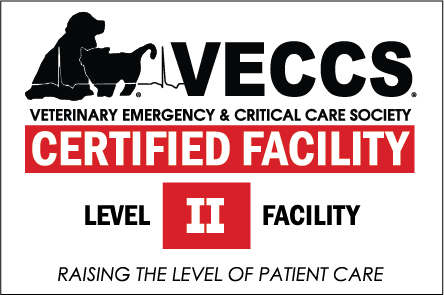Magnetic Resonance Imaging (MRI or MR) is the most advanced diagnostic imaging tool available. This safe, non-invasive procedure allows more complete viewing of the body than any other modality. This technology uses no ionizing radiation, such as x-rays. The patient is placed onto a table surrounded by a powerful magnet. Minute signals are produced as the body responds to the magnetic field. These signals are converted to a cross-sectional image, allowing radiologists and other specialists to look deep into the body for injury or disease.
The MRI Service performs hundreds of examinations per year on dogs, cats, and exotic pets. Now seen as the gold standard for examining the brain and spine, MRI has replaced many of the more invasive procedures of the past. Common diseases diagnosed include spinal disk herniation, brain tumors, trauma of the brain and spine, strokes, and brain malformations. MRI has lead to earlier and more accurate diagnosis for these and other diseases. Important advances in the knowledge of spinal cord injury from disk herniation, infectious and degenerative brain diseases, and brain tumors have been made by the specialists here at the Veterinary Medical Teaching Hospital at Texas A&M. Using MRI, specialists can give more accurate answers to important questions, such as the likeliness that a patient will walk again following a disk herniation. This allows owners to make more informed decisions for their pets and families.
MRI is also a powerful tool for examining the skeleton, including bone, tendons, ligaments, and joints. As the technology advances, specialists are finding endless uses for MRI. With the opening of the Diagnostic Imaging and Cancer Treatment Center (DICTC) at the Veterinary Medical Teaching Hospital at Texas A&M in 2011, we have upgraded to the most powerful magnet approved for clinical patients. Our 3 Tesla MRI makes us one of only a handful of veterinary institutions in the country with the same capabilities. The uses of our MRI include studies of the heart in motion, tracking of nerve fibers in the brain and spine, and spectroscopy which allows more definitive typing of brain tumors without the need for biopsy.
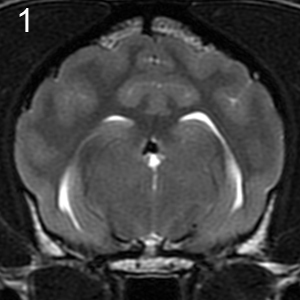 Figure 1. (Left An MRI image of a normal dog brain
Figure 1. (Left An MRI image of a normal dog brain
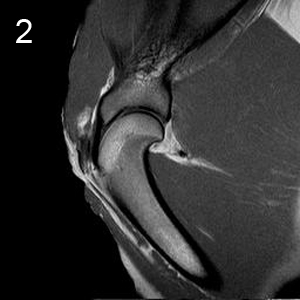
Figure 2. (right) An MRI image of a normal dog shoulder
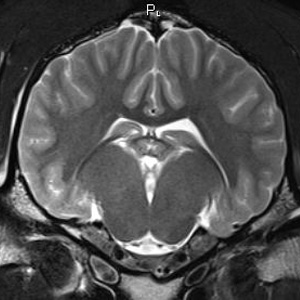
Figure 3. (left) An MRI image of a normal horse brain
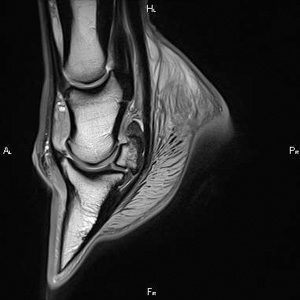
Figure 4. (right An MRI image of a normal horse foot
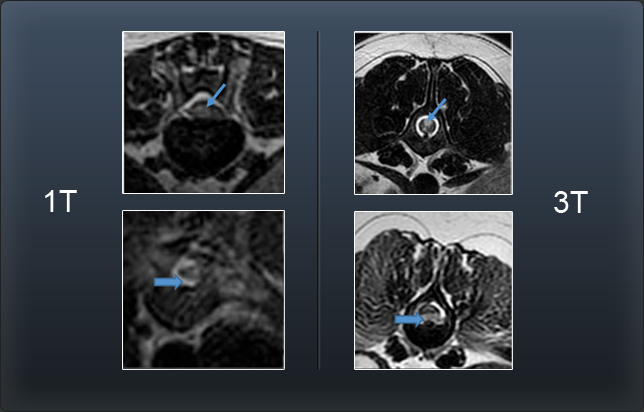
Upper panels: MR images from two dogs with spinal cord injury due to fibrocartilagenous embolism. This disease usually results in well demarcated, bright areas (hyperintensities) within the spinal cord. The dog on the left was imaged with 1T MR and has a centrally located bright area within the spinal cord (blue arrow) that is challenging to see. The dog on the right was imaged at 3T – note the sharp borders surrounding the bright lesion area.
Lower panels: MR images from two dogs with spinal cord injury due to disk herniation. The image on the left was produced with a 1T MRI. There is compressive material (blue arrow) below the spinal cord that is bright. The dog on the right was imaged with 3T – note the clarity of the image, how easy it is to see compressive material (blue arrow) and overlying spinal cord.
3T MRI image of a horse foot. The navicular bone, flexor tendon, coffin bone, and surrounding structures can all be evaluated. Signal from fat has been suppressed, making the bones dark so that bone injuries can be seen.


